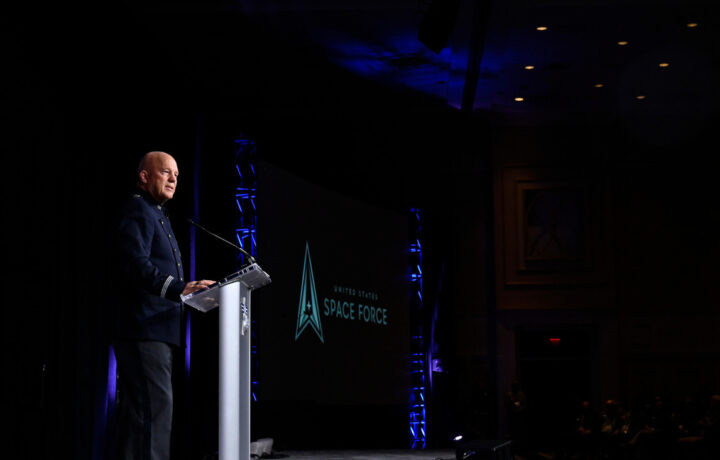On Wednesday, the first chief of the United States Space Force – the sixth and newest branch of the United States military – boldly followed other military leaders into retirement after 38 years of military service. General John “Jay” Raymond served as the first chief of space operations from 2019, and as the first guardian, also served as commander of the United States Space Command from 2019 to 2020.
Raymond, who was raised in a military family, was commissioned into the United States Air Force in 1984 after graduating from Clemson University, where he took part in the ROTC program. He was a career missile and space operations officer, and previously commanded the 5th Space Surveillance Squadron, 30th Operations Group, Fourteenth Air Force, Joint Force Space Component Command, and Air Force Space Command. He assumed command of the Air Force Space Command in 2016. He had previously been deployed to Afghanistan and Iraq.
Command was officially relinquished to General B. Chance Saltzman in a ceremony at Joint Base Andrews, MD.
Father of the Space Force
Speaking during the change of command, Air Force Secretary Frank Kendall praised Raymond for his ground-level work, and described him as “the father of the Space Force.” While he served at the helm of the newly established service since 2019, when Congress officially authorized the Space Force, Raymond also led the military’s newest combatant command, U.S. Space Command.
“The Space Force that I walked in on 15 months ago, the one that Gen. Saltzman will be stepping up to lead . . . is a living, breathing testament to the vision, professionalism and will to succeed that Gen. Raymond brought to his role as the first chief of space operations,” Kendall said.
Defense Secretary Lloyd Austin also praised Raymond’s leadership, which he added would leave a lasting impact on the Space Force.
“He laid the foundation for the culture and the traditions that will define the service for decades to come,” Austin said. “He did all of that, and he made it look easy.”
It could be argued that it was actually a lot of hard work.
In December 2019, Raymond was the first official member of the new service and immediately had to start building it from the ground up. That included transferring people and funding from the Air Force’s space units. In addition, Raymond had to navigate a charged political landscape as the Space Force in its early days was viewed as a vanity project of former President Trump and was even parodied on a Netflix show.
However, fast forward to November 2022, and the TV satire has been canceled, while Space Force’s mission has become ever clearer. Instead of reversing course on the newest branch of the military, the Biden administration had boosted the service’s budget amid concerns that U.S. satellites could become military targets and need to be better defended.
Raymond called attention to U.S. military and intelligence assessments that Russia had begun to deploy anti-satellite weapons that could threaten U.S. systems. He further urged the Space Force to innovate faster to stay ahead of China, and also advocated for the U.S. and all other nations to adopt “norms of behavior” to keep outer space safe from weapons and debris.
Bold Thinking
In September, Raymond gave his unofficial farewell during the keynote at the Air Force Association’s Air, Space & Cyber Conference, in which he told U.S. Space Force guardians and U.S. Air Force airmen that the newest service is now on strong footing and has avoided two major traps.
The first trap was that “we wouldn’t think bold enough. The second challenge was that when we did think bold the bureaucracy might stifle our bold thinking,” he explained. ‘We were dead set against either one of these happening. And if we did this right we wanted all of the other services looking over our shoulder jealous about what we built because we had an opportunity to start with a clean sheet of paper.”
Though Raymond said those pitfalls were successfully avoided, he added that there was still much work to be done.
“The United States Space Force has just begun, and it has a great history ahead. I couldn’t be more excited for the future of the Space Force.”
A New Leader at the Helm
Gen. Saltzman had most recently served as deputy chief of space operations, with a focus on the service’s cyber and nuclear forces. He joined the Air Force in 1991 and has experience as an intercontinental ballistic missile officer and a satellite operator for the National Reconnaissance Office and has held leadership roles within the Air Force and U.S. Central Command.
Saltzman, who was Raymond’s top choice to succeed him, will now lead a Space Force that has grown to about 16,000 personnel – half of whom are in uniform and half civilian. The service now has a $24 billion annual budget, and could further be on a growth spurt due to continued threats from China and Russia.
The new chief said he had hoped to build a force ready for the challenges of tomorrow, but admitted it won’t be an easy or short-lived task, adding, “A resilient, ready and combat-capable Space Force is indispensable to deterrence today, tomorrow and every day after that.”


